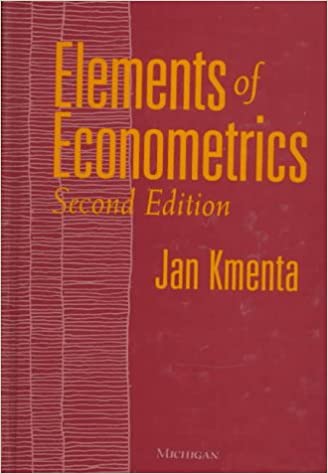This classic text has proven its worth in university classrooms and as a tool kit in research--selling over 40,000 copies in the United States and abroad in its first edition alone. Users have included undergraduate and graduate students of economics and business, and students and researchers in political science, sociology, and other fields where regression models and their extensions are relevant. The book has also served as a handy reference in the "real world" for people who need a clear and accurate explanation of techniques that are used in empirical research.
Throughout the book the emphasis is on simplification whenever possible, assuming the readers know college algebra and basic calculus. Jan Kmenta explains all methods within the simplest framework, and generalizations are presented as logical extensions of simple cases. And while a relatively high degree of rigor is preserved, every conflict between rigor and clarity is resolved in favor of the latter. Apart from its clear exposition, the book's strength lies in emphasizing the basic ideas rather than just presenting formulas to learn and rules to apply.
The book consists of two parts, which could be considered jointly or separately. Part one covers the basic elements of the theory of statistics and provides readers with a good understanding of the process of scientific generalization from incomplete information. Part two contains a thorough exposition of all basic econometric methods and includes some of the more recent developments in several areas.
As a textbook, Elements of Econometrics is intended for upper-level undergraduate and master's degree courses and may usefully serve as a supplement for traditional Ph.D. courses in econometrics. Researchers in the social sciences will find it an invaluable reference tool.
A solutions manual is also available for teachers who adopt the text for coursework.
Jan Kmenta is Professor Emeritus of Economics and Statistics, University of Michigan.
چکیده فارسی
این متن کلاسیک ارزش خود را در کلاس های درسی دانشگاه و به عنوان یک بسته ابزار در تحقیقات ثابت کرده است - تنها در اولین نسخه خود بیش از 40000 نسخه در ایالات متحده و خارج از کشور فروخته است. کاربران شامل دانشجویان کارشناسی و کارشناسی ارشد اقتصاد و بازرگانی و دانشجویان و محققان علوم سیاسی، جامعهشناسی و سایر زمینههایی هستند که مدلهای رگرسیون و بسط آنها مرتبط هستند. این کتاب همچنین به عنوان یک مرجع مفید در "دنیای واقعی" برای افرادی که نیاز به توضیح واضح و دقیق از تکنیک های مورد استفاده در تحقیقات تجربی دارند، عمل کرده است.
در سرتاسر کتاب تاکید بر ساده سازی هر زمان ممکن است، با این فرض که خوانندگان جبر کالج و حساب دیفرانسیل و انتگرال را می دانند. Jan Kmenta همه روشها را در سادهترین چارچوب توضیح میدهد و تعمیمها به عنوان بسط منطقی موارد ساده ارائه میشوند. و در حالی که درجه نسبتاً بالایی از دقت حفظ می شود، هر تعارض بین دقت و وضوح به نفع دومی حل می شود. جدای از توضیح واضح آن، نقطه قوت کتاب در تأکید بر ایده های اساسی به جای ارائه فرمول هایی برای یادگیری و قوانینی برای به کارگیری است.
کتاب از دو بخش تشکیل شده است که می توان آنها را به صورت مشترک یا جداگانه در نظر گرفت. بخش اول عناصر اساسی تئوری آمار را پوشش می دهد و درک خوبی از روند تعمیم علمی از اطلاعات ناقص به خوانندگان ارائه می دهد. بخش دوم شامل توضیح کاملی از تمام روشهای اصلی اقتصاد سنجی است و شامل برخی از پیشرفتهای اخیر در چندین زمینه است.
به عنوان یک کتاب درسی، Elements of Econometrics برای دورههای مقطع کارشناسی و کارشناسی ارشد در سطح بالا در نظر گرفته شده است و ممکن است به عنوان مکملی برای دورههای دکتری سنتی استفاده شود. دوره های اقتصاد سنجی محققان علوم اجتماعی آن را یک ابزار مرجع ارزشمند خواهند یافت.
راهنمای راه حل ها نیز برای معلمانی که متن را برای کار درسی می پذیرند در دسترس است.
جان کیمنتا استاد بازنشسته اقتصاد و آمار دانشگاه میشیگان است.
ادامه ...
بستن ...










